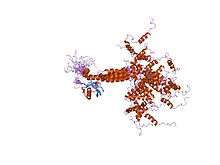Ubiquitin-interacting motif
| UIM | |||||||||
|---|---|---|---|---|---|---|---|---|---|
 solution structure of s5a uim-1/ubiquitin complex | |||||||||
| Identifiers | |||||||||
| Symbol | UIM | ||||||||
| Pfam | PF02809 | ||||||||
| InterPro | IPR003903 | ||||||||
| SCOP | 1p9d | ||||||||
| SUPERFAMILY | 1p9d | ||||||||
| |||||||||
In molecular biology, the Ubiquitin-Interacting Motif (UIM), or 'LALAL-motif', is a sequence motif of about 20 amino acid residues, which was first described in the 26S proteasome subunit PSD4/RPN-10 that is known to recognise ubiquitin.[1][2] In addition, the UIM is found, often in tandem or triplet arrays, in a variety of proteins either involved in ubiquitination and ubiquitin metabolism, or known to interact with ubiquitin-like modifiers. Among the UIM proteins are two different subgroups of the UBP (ubiquitin carboxy-terminal hydrolase) family of deubiquitinating enzymes, one F-box protein, one family of HECT-containing ubiquitin-ligases (E3s) from plants, and several proteins containing ubiquitin-associated UBA and/or UBX domains.[3] In most of these proteins, the UIM occurs in multiple copies and in association with other domains such as UBA (INTERPRO), UBX (INTERPRO), ENTH domain, EH (INTERPRO), VHS (INTERPRO), SH3 domain, HECT, VWFA (INTERPRO), EF-hand calcium-binding, WD-40, F-box (INTERPRO), LIM, protein kinase, ankyrin, PX, phosphatidylinositol 3- and 4-kinase (INTERPRO), C2 domain, OTU (INTERPRO), DnaJ domain (INTERPRO), RING-finger (INTERPRO) or FYVE-finger (INTERPRO). UIMs have been shown to bind ubiquitin and to serve as a specific targeting signal important for monoubiquitination. Thus, UIMs may have several functions in ubiquitin metabolism each of which may require different numbers of UIMs.[4][5][6]
The UIM is unlikely to form an independent protein domain. Instead, based on the spacing of the conserved residues, the motif probably forms a short alpha-helix that can be embedded into different protein folds.[2] Some proteins known to contain an UIM are listed below:
- Eukaryotic PSD4/RPN-10/S5, a multi-ubiquitin binding subunit of the 26S proteasome.
- Vertebrate Machado-Joseph disease protein 1 (Ataxin-3), which acts as a histone-binding protein that regulates transcription; defects in Ataxin-3 cause the neurodegenerative disorder Machado-Joseph disease (MJD).
- Vertebrate epsin and epsin2.
- Vertebrate hepatocyte growth factor-regulated tyrosine kinase substrate (HRS).
- Mammalian epidermal growth factor receptor substrate 15 (EPS15), which is involved in cell growth regulation.
- Mammalian epidermal growth factor receptor substrate EPS15R.
- Drosophila melanogaster (Fruit fly) liquid facets (lqf), an epsin.
- Yeast VPS27 vacuolar sorting protein, which is required for membrane traffic to the vacuole.
References
- ↑ Young P, Deveraux Q, Beal RE, Pickart CM, Rechsteiner M (March 1998). "Characterization of two polyubiquitin binding sites in the 26 S protease subunit 5a". J. Biol. Chem. 273 (10): 5461–7. PMID 9488668. doi:10.1074/jbc.273.10.5461.
- 1 2 Hofmann K, Falquet L (June 2001). "A ubiquitin-interacting motif conserved in components of the proteasomal and lysosomal protein degradation systems". Trends Biochem. Sci. 26 (6): 347–50. PMID 11406394. doi:10.1016/s0968-0004(01)01835-7.
- ↑ Buchberger A (May 2002). "From UBA to UBX: new words in the ubiquitin vocabulary". Trends Cell Biol. 12 (5): 216–21. PMID 12062168. doi:10.1016/S0962-8924(02)02269-9.
- ↑ Oldham CE, Mohney RP, Miller SL, Hanes RN, O'Bryan JP (July 2002). "The ubiquitin-interacting motifs target the endocytic adaptor protein epsin for ubiquitination". Curr. Biol. 12 (13): 1112–6. PMID 12121618. doi:10.1016/S0960-9822(02)00900-4.
- ↑ Riezman H (March 2002). "Cell biology: the ubiquitin connection". Nature. 416 (6879): 381–3. PMID 11919614. doi:10.1038/416381a.
- ↑ Reece DE, Barnett MJ, Connors JM, Fairey RN, Fay JW, Greer JP, Herzig GP, Herzig RH, Klingemann HG, LeMaistre CF (October 1991). "Intensive chemotherapy with cyclophosphamide, carmustine, and etoposide followed by autologous bone marrow transplantation for relapsed Hodgkin's disease". J. Clin. Oncol. 9 (10): 1871–9. PMID 1919637.
This article incorporates text from the public domain Pfam and InterPro IPR003903